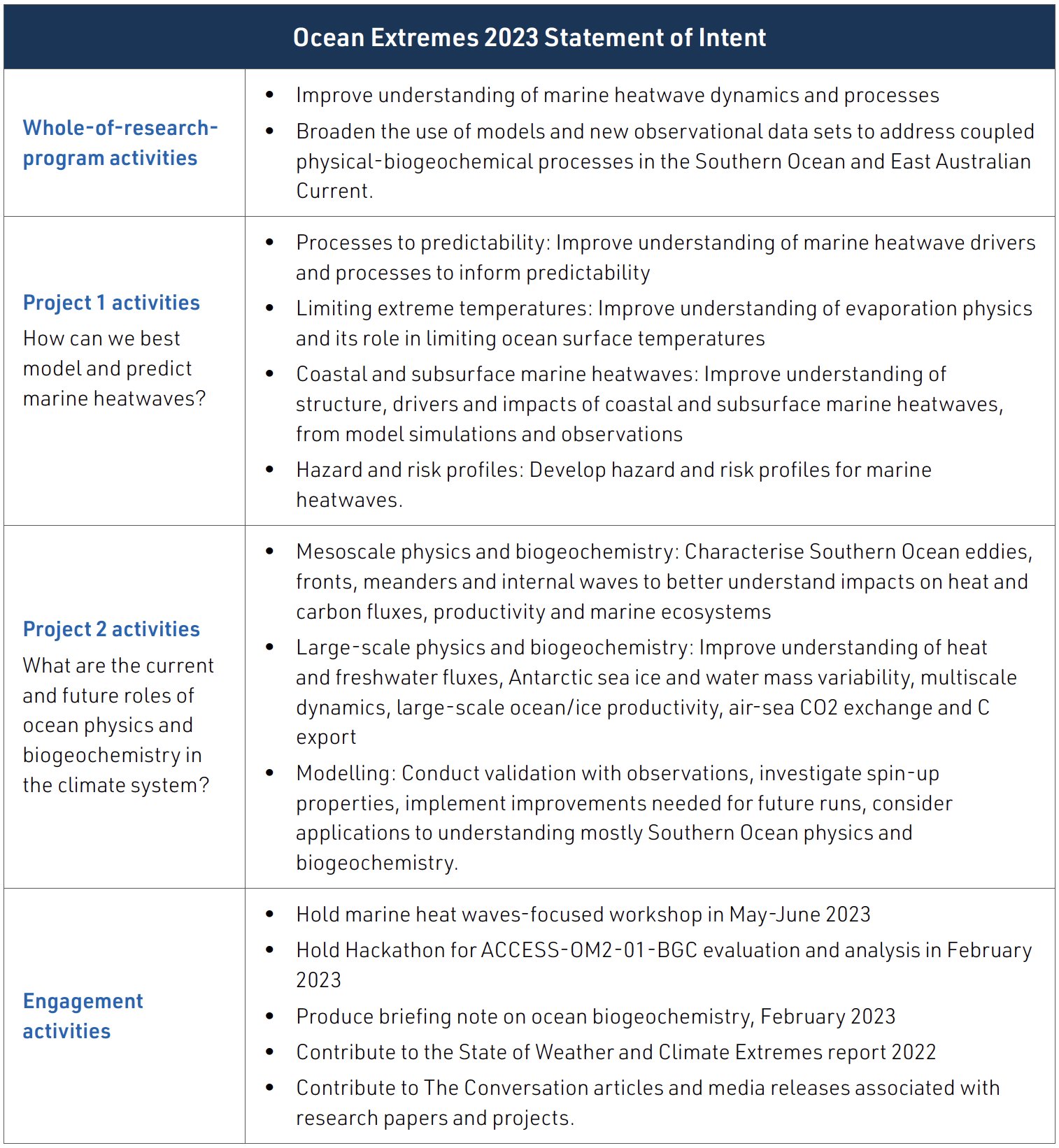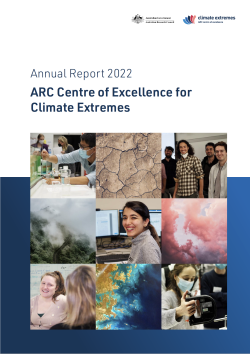The ARC Centre of Excellence for Climate Extremes’ Ocean Extremes research program published a range of groundbreaking research keenly focused on our three research projects and the program continued significant interactions with policymakers and industry in 2022.
We have had a number of striking papers published. Some, like the paper that explored a massive phytoplankton bloom in the South Pacific, generated significant media coverage, while others had smaller media impact but a profound impact on our understanding of ocean processes. For example, research published in Geophysical Research Letters elaborated on our 2021 ‘bushfires and blooms’ paper to explain how the recycling of dissolved iron, delivered by 2019-20 bushfire aerosols, helped to sustain a massive phytoplankton bloom in the Pacific sector of the Southern Ocean
On October 31 and November 1, 2022, students, researchers and stakeholders of the program gathered in Hobart and over Zoom to hold the second Ocean Extremes program workshop. The main objectives of the workshop were to get the Ocean Extremes team together; share current research and outline where it is going; facilitate collaborations in and around the Centre of Excellence; and foster dialogue with key marine stakeholders, to better understand their concerns and needs.
The workshop consisted of four key components: science sessions on observations, modelling and prediction, as well as presentations by colleagues with expertise in stakeholder engagement – namely, Richard Eccleston, Director of the Tasmanian Policy Exchange and Kathleen Beyer, from Climate Futures Tasmania.
PROJECT 1
Marine heatwaves: How can we best model and predict marine heatwaves?
Ocean Extremes program researchers have developed a new catalogue of marine heatwave metrics and trends for the Australian region as well as a global multi-product of coastal marine heatwaves, which will provide valuable data sets against which to test model hindcasts (back predictions). Program researchers have also analysed modelled climate change projections of marine heatwaves across the tropical western and central Pacific Islands region, to better understand potential impacts on communities in the future.
New insights have been gained into the processes that produce shallow marine heatwaves, such as those that led to bleaching events over the Great Barrier Reef during cool La Niña periods. These insights will help forecast such events in the short term. Looking to the longer term, a high-resolution model investigation of marine heatwaves around Australia and New Zealand has revealed how climate change will alter local hotspots, showing warming impacts by the East Australian Current, around Tasmania and in waters close to New Zealand.
PROJECT 2
Mesoscale ocean processes: How do marine heatwaves interact with other climate extremes?
There have been significant advances in this project. Highlights from 2022 include a comprehensive review of Indian Ocean systems and interactions, which is foundational to understanding the processes that generate ocean extremes; a paper highlighting the future impacts of warmer oceans on Antarctica; and another paper examining the processes in a warmer world that lead to amplification effects in certain areas that create marine heatwave hotspots here in Australia and around the world.
PROJECT 3
Biogeochemistry: What are the current and future roles of mesoscale physics and biogeochemistry in the climate system?
Student publications were again the engine room of this project’s achievements in 2022. Land-ocean connections were further explored, with more detailed analysis of the way in which the 2019-20 south-east Australia fires impacted ocean productivity. Deposition of fire aerosols onto the ocean surface, thousands of kilometres from the fires themselves, stimulated a phytoplankton bloom that was visible from space for months. Other student projects combined ship observations with autonomous platforms (satellites and floats) to look at the interaction of physics and ocean productivity in the sea ice zone and the Antarctic Circumpolar Current south of Tasmania.
In the Antarctic Circumpolar Current, eddies were implicated as drivers of nutrient inputs to the surface from below. Close to the Antarctic continent, careful experiments quantified the importance of iron and light as regulators of productivity. And from several different approaches, mostly using data from biogeochemical Argo floats, large-scale analyses have contributed to an ongoing debate about the amount of productivity and carbon uptake occurring in the Southern Ocean, with implications for global carbon budgets.

RESEARCH SNAPSHOT
A BGC-Argo float is deployed from RV Investigator in January 2021. Credit: Jakob Weis.
Annual net community production is the amount of biologically produced carbon available for export to the deep ocean. Ocean Extremes program researchers developed a novel approach to estimate annual net community production in the Southern Ocean, using robotic biogeochemical Argo (BGC-Argo) floats.
Using our improved method, we calculated total Southern Ocean annual net community production to be 3.89 billion tonnes of carbon per year. This estimate is much larger than previous estimates, which suggests a more important role than previously thought for the Southern Ocean in regulating oceanic carbon storage, atmospheric CO2 exchange and climate.
Su, J., Schallenberg, C., Rohr, T., Strutton, P.G., Phillips, H.E., 2022. New estimates of Southern Ocean annual net community production revealed by BGC-Argo floats. Geophysical Research Letters 49, e2021GL097372. https://doi.org/10.1029/2021GL097372
RESEARCH SNAPSHOT

Phytoplankton, microscopic marine algae that photosynthesize, facilitate the sequestration of carbon dioxide from the atmosphere into the ocean, thus contributing to the regulation of global climate. In the Southern Ocean, phytoplankton productivity is limited by micronutrients, including iron.
Light is also important, because it undergoes such strong seasonal extremes. The relative dominance of iron and light limitation on phytoplankton growth is important to our understanding of how primary production, and the sequestration of carbon dioxide, will change in a future warming ocean. Program researchers conducted a series of incubation experiments during a research voyage off East Antarctica to investigate iron and light limitation in the austral summer. Our results show that, while light was the primary limiting factor of phytoplankton growth, iron favoured growth only under high light conditions.
Our results provide new insight into these processes from a poorly sampled area of the Southern Ocean, improving our understanding of how phytoplankton production will change in the future.
Vives, C.R., Schallenberg, C., Strutton, P.G., Westwood, K.J., 2022. Iron and light limitation of phytoplankton growth off East Antarctica. Journal of Marine Systems 234, 103774. https://doi.org/10.1016/j.jmarsys.2022.103774

ARC Centre of Excellence for Climate Extremes – Annual Report 2023
From the Chair of the Advisory Board
Climate Science Leaders of the Future
Weather and Climate Interactions Research Program
Attribution and Risk Research Program
Ocean Extremes Research Program
Computational Modelling Systems
Governance, Management and our Commitment to Equity, Diversity and Inclusion

